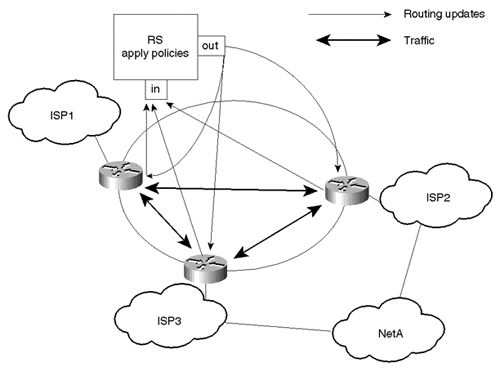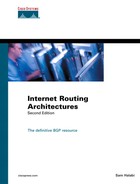Routing Arbiter Project
Another project for which the NSF solicited services is the Routing Arbiter (RA) project[4], which is charged with providing equitable treatment of the various network service providers with regard to routing administration. The RA provides for a common database of route information to promote stability and manageability of networks.
Multiple providers connecting to the NAP created a scalability issue because each provider had to peer with all other providers to exchange routing and policy information. The RA project was developed to reduce the requirement for a full peering mesh between all the providers. Instead of peering among each other, providers can peer with a central system called a route server. The route server would maintain a database of all information needed for providers to set their routing policies. Figure 1-6 shows the physical connectivity and logical peering between a route server and various service providers.
Figure 1-6. Route Server Handling of Routing Updates in Relation to Traffic Routing

The following are the major tasks of the RA per the NSF proposal:
-
Promote Internet routing stability and manageability. The route server accomplishes much of this task by reducing the number of BGP peers a router is required to maintain and by applying policy before passing routing information on to the peer, thereby alleviating the processing resources required by the router to filter the routing information.
-
Establish and maintain network topology databases by such means as exchanging routing information with and dynamically updating routing information from the attached autonomous systems (ASs) using standard Exterior Gateway Protocols (EGPs), such as BGP (Border Gateway Protocol) and IDRP (support for IP and CLNP).
-
Propose and establish procedures to work with personnel from the NAP manager(s), the vBNS provider, and regional and other attached networks to resolve problems and to support end-to-end connectivity and QoS for network users.
-
Develop advanced routing technologies such as type of service and precedence routing, multicasting, bandwidth on demand, and bandwidth allocation services, in cooperation with the global Internet community.
-
Provide for simplified routing strategies, such as default routing for attached networks.
-
Promote distributed operation and management of the Internet.
The RA project was a joint effort of Merit Network, Inc., the University of Southern California Information Sciences Institute (USC ISI) [5], Cisco systems (as a subcontractor to ISI), and the University of Michigan ROC (as a subcontractor to Merit).
The RA service was comprised of four projects:
-
Route server (RS)— The RS can be as simple as a Sun workstation deployed at each NAP. The route server exchanges only routing information with the service provider routers attached to the NAP. Individual routing policy requirements (RIPE 181)[6] for each provider are maintained. The route server itself does not forward packets or perform any switching function between service providers.
The server facilitates interconnection between ISPs by gathering routing information from each ISP's predefined rules and policies and then redistributing the processed routing information to each ISP. This process saves each router from having to peer with every other router, thus decreasing the number of peers from (n–1) to 1, where n is the number of routers.
In this configuration, the routers of the different providers concentrate on switching the traffic between one another and do relatively little filtering and policy application.
-
Network Management System— This software monitors the performance of the RS. Distributed rovers run at each RS and collect information such as performance statistics. The central network management station (CNMS) at the Merit Routing Operations Center queries the rovers and processes the information.
-
Routing Arbiter Database (RADB)[7]— This is one of several routing databases collectively known as the Internet Routing Registry (IRR). Policy routing in the RADB is expressed by using RIPE-181 syntax, developed by the RIPE Network Coordination Center (RCC). The RADB was developed in dual mode with the Policy Routing Database (PRDB). The PRDB had been used to configure the NSFNET's backbone routers since 1986. With the introduction of the RIPE-181 language, which provided better functionality in recording global routing policies, the PRDB was retired in 1995 for full RADB functionality.
-
Routing engineering team— This team works with the network providers to set up peering and to resolve network problems at the NAP. The Routing Engineering Team provides consultation on routing strategies, addressing plans, and other routing-related issues.
In practice, route servers play an important security role by verifying the authenticity of routing updates from participants, disallowing bogus routing information to be advertised to peers.
As you have already seen, the main parts of the Routing Arbiter concept are the route server and the RADB. The practical and administrative goals of the RADB apply mainly to service providers connecting to the NAP. Configuring the correct information in the RADB is essential in setting the required routing policies.
In the first edition of this book, Appendix A was devoted entirely to coverage of RIPE-181. However, most IRRs currently are transitioning to a new policy specification language, RPSL (Routing Policy Specification Language). RPSL is the next-generation language for defining policy in the IRRs. It was developed by the Internet Engineering Task Force (IETF)[8] Routing Policy System (RPS) Working Group. It was defined in RFC 2622 and explained in RFC 2650, with leadership from USC ISI. Because RPSL will quickly make RIPE-181 obsolete, Appendix A now includes information on RPSL from RFC 2650, "Using RPSL in Practice."
There are many reasons for the transition from RIPE-181 to RPSL, most of which were observed only after a considerable amount of deployment experience with the RIPE-181 language. RPSL enhancements include scalability of policy syntax and authentication mechanisms that promote integrity of addressing and policy information between network operators. For more information on RPSL, see Appendix A.
As a customer of a service provider, you may never have to configure RIPE-181 or RPSL. However, you should understand the reasoning behind the policies being defined with these languages. As you will see in this book, policies are the basis of routing architectures and behaviors.
On the other hand, the concept of a route server and peering with centralized routers is not restricted to providers at NAPs. It could be implemented in any architecture that needs it. As part of the implementation section of this book, the route server concept will come up as a means of creating a one-to-many relationship between peers. It's also worth noting that providers that are present at NAPs are not required to peer via the route servers, and providers that connect via direct interconnections are highly unlikely to use the route servers at all.
In March 1998, Merit successfully completed work on the Routing Arbiter project. Today, Merit and its RA project partner, the University of Southern California Information Sciences Institute, continue to carry out research in the areas surrounding the RA project.
Following recommendations from NSF, Merit completed work with ISI to transition the RA route servers to Route Server Next Generation (RSng), which commercialized the use of the Route Server services from Merit, allowing exchange point operators to purchase their services. NSF also recommended that, concurrent with commercialization of the router server services, NAP operations be commercialized, stating that they've accomplished the goal of establishing that ISPs can cooperate in a competitive market.
In 1997, Merit began NSF-funded work on Internet Performance Measurement and Analysis (IPMA). The goal of IPMA is to study the performance of networks and networking protocols through the collection and analysis of routing and network performance statistics in order to promote Internet stability. IPMA also develops tools to help facilitate network operations and engineering functions.
North American Network Operators Group (NANOG)[9] was initially funded by NSF during both the NSFNET and early RA days and originated from the NSFNET's regional technical meetings. It's now funded independently through conference registration fees, with Merit acting as the organizer. NANOG provides a forum for the discussion of technical issues associated with operating networks in North America.
Databases and tools created through the RADB projects are widely used by ISPs and have become an embedded part of the Internet today.
In order to provide stability and security to the global Internet routing scheme, there is still much work to be done in the interdomain policy specification and application space. Projects such as the RA provide a great deal of insight as to how Internet network architects should approach the issue.
